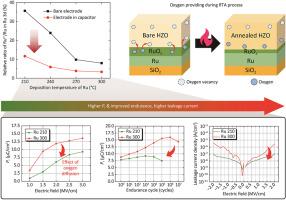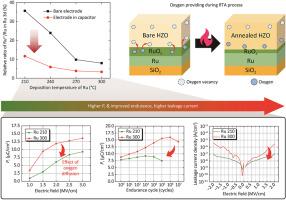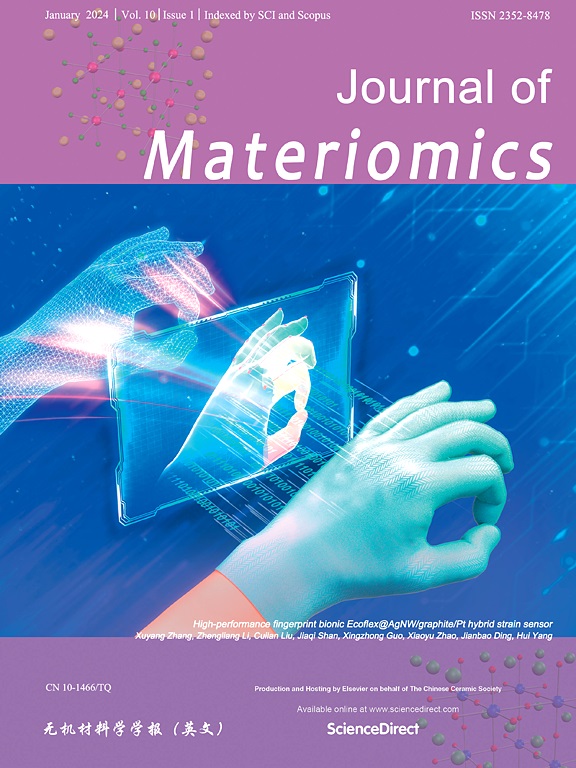利用氧含量调制Ru电极研究铁电材料Hf0.5Zr0.5O2的界面氧化还原化学
IF 9.6
1区 材料科学
Q1 CHEMISTRY, PHYSICAL
引用次数: 0
摘要
研究了原子层沉积法制备Ru电极中氧含量对Hf0.5Zr0.5O2薄膜铁电性的影响。通过将沉积温度从210°C调节到300°C,可以调节Ru中的氧含量。Ru中较高的氧含量降低了随后生长的Hf0.5Zr0.5O2膜中的氧空位浓度,从而减轻了唤醒效应。而随着Ru沉积温度的降低,单斜相分数增加,导致残余极化减小。与高温下生长的电极相比,210℃下沉积的Ru电极由于氧扩散导致氧空位浓度降低,以及较高的O含量导致Ru的功函数增大,从而降低了泄漏电流密度。然而,在210°C沉积的Ru上生长的Hf0.5Zr0.5O2薄膜的开关寿命比在更高温度下沉积的Ru短2个数量级,这是由于氧扩散引起的界面损伤。这一观察结果表明,当使用原子层沉积的Ru电极来研究界面氧化还原化学的影响时,电极与Hf0.5Zr0.5O2之间的界面氧化还原反应对缺陷浓度、多态性以及由此产生的铁电性有重要影响。本文章由计算机程序翻译,如有差异,请以英文原文为准。


Utilization of oxygen content modulated Ru electrode to examine the interfacial redox chemistry of ferroelectric Hf0.5Zr0.5O2
The impact of oxygen content in the Ru electrode, grown using atomic layer deposition on ferroelectricity in Hf0.5Zr0.5O2 film is investigated. The oxygen content in Ru can be modulated by simply adjusting the deposition temperature from 210 °C to 300 °C. Higher oxygen content in Ru reduces the oxygen vacancy concentration in subsequently grown Hf0.5Zr0.5O2 film, thereby mitigating the wake-up effect. However, the monoclinic phase fraction increased with decreasing Ru deposition temperature, resulting in a decrease in remanent polarization. The decreased oxygen vacancy concentration by oxygen diffusion from Ru electrode deposited at 210 °C could decrease the leakage current density compared to that grown at higher temperatures. Nonetheless, the switching endurance of Hf0.5Zr0.5O2 film grown on Ru deposited at 210 °C was shorter than those on Ru deposited at 300 °C by 2 order of magnitude, being attributed to the oxygen diffusion caused interfacial damages. This observation suggests that the interfacial redox reactions between the electrode and Hf0.5Zr0.5O2 critically influence defect concentration, polymorphism, and the resulting ferroelectricity when using an atomic layer deposited Ru electrode to examine the impact of interfacial redox chemistry.
求助全文
通过发布文献求助,成功后即可免费获取论文全文。
去求助
来源期刊

Journal of Materiomics
Materials Science-Metals and Alloys
CiteScore
14.30
自引率
6.40%
发文量
331
审稿时长
37 days
期刊介绍:
The Journal of Materiomics is a peer-reviewed open-access journal that aims to serve as a forum for the continuous dissemination of research within the field of materials science. It particularly emphasizes systematic studies on the relationships between composition, processing, structure, property, and performance of advanced materials. The journal is supported by the Chinese Ceramic Society and is indexed in SCIE and Scopus. It is commonly referred to as J Materiomics.
 求助内容:
求助内容: 应助结果提醒方式:
应助结果提醒方式:


